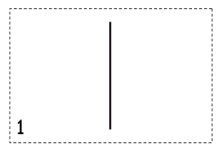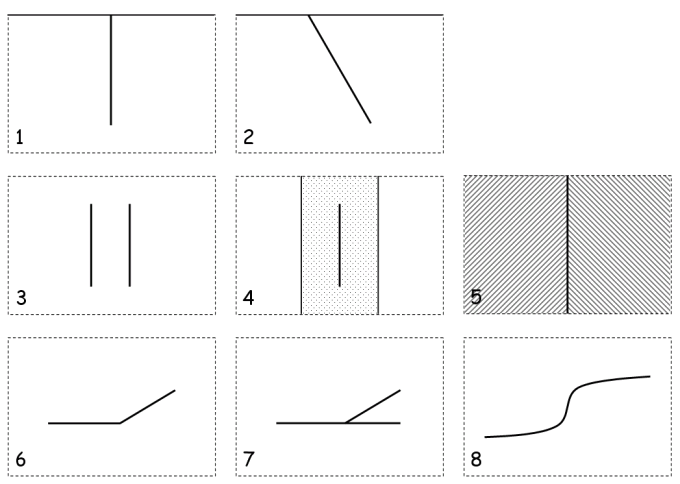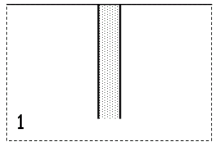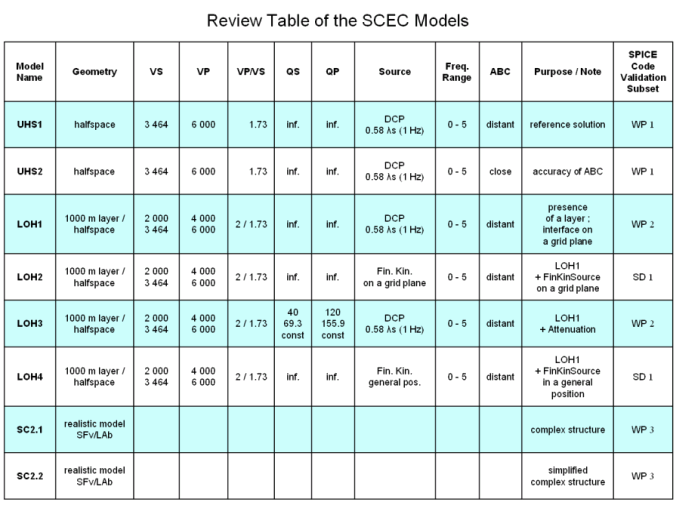The interactive web interface
Verification and Validation
Wave Propagation (WP) Model Set
Source Dynamics (SD) Model Set
Quantitative Misfit Criteria for Comparison of Seismograms
Historical note
The interactive web interface
for verifying numerical-modeling methods in seismology
Numerical-modeling methods are important and irreplaceable tools in earthquake research, imaging the Earth's structure, and in seismic exploration. This is due to several factors – mainly inherent limitations of direct controlled experiments in seismology, complexity of the structure and processes in the Earth, and the very fact that no exact mathematical methods can be applied to realistic computational models of the Earth's interior. Despite the large variety of methods and years of their development there is still an obvious need to develop new approaches that will be both more accurate for realistic models and computationally efficient on the ever evolving computational hardware.
SISMOWINE is intended as a long-term interactive web interface for verifying numerical-modeling methods in seismology. Numerical-method developers and numerical modelers may upload their solutions for the defined problem configurations and compare their solutions with other solutions. SISMOWINE is a continuation of the original SPICE Code Validation interface established within the 6th Framework Programme project SPICE (http://www.spice-rtn.org). For the original SPICE Code Validation see the Historical Note. The SISMOWINE interactive web interface has been developed by the computational seismology team at the Comenius University Bratislava.
The use of the interface is easy and the web pages navigate participant step by step from the model selection up to comparison of his solution with a reference or any other selected solution. Participants can use several computational methods/codes and upload several solutions for each model. Participants are encouraged to develop and suggest new models useful for testing and comparing numerical-modeling methods.
SISMOWINE is intended as a long-term interactive web interface for verifying numerical-modeling methods in seismology. Numerical-method developers and numerical modelers may upload their solutions for the defined problem configurations and compare their solutions with other solutions. SISMOWINE is a continuation of the original SPICE Code Validation interface established within the 6th Framework Programme project SPICE (http://www.spice-rtn.org). For the original SPICE Code Validation see the Historical Note. The SISMOWINE interactive web interface has been developed by the computational seismology team at the Comenius University Bratislava.
The use of the interface is easy and the web pages navigate participant step by step from the model selection up to comparison of his solution with a reference or any other selected solution. Participants can use several computational methods/codes and upload several solutions for each model. Participants are encouraged to develop and suggest new models useful for testing and comparing numerical-modeling methods.
Verification and Validation
The SISMOWINE should serve for verification of the methods. The verification should be clearly distinguished from validation. Here we characterize both concepts:
Verification of the numerical-modeling method = the check of the capability of the method to numerically solve a problem defined by the equations of motion, constitutional laws, and initial/boundary conditions with an optional level of accuracy (in other words, the check of consistency of the numerical representation with the mathematical-physical problem).
Validation of the mathematical-physical model = the check of the capability of the model to reproduce data.
Verification of the numerical-modeling method = the check of the capability of the method to numerically solve a problem defined by the equations of motion, constitutional laws, and initial/boundary conditions with an optional level of accuracy (in other words, the check of consistency of the numerical representation with the mathematical-physical problem).
Validation of the mathematical-physical model = the check of the capability of the model to reproduce data.
Problem Configurations
Wave Propagation ( WP ) Model Set
Simplest canonical models
|
Subset WP II
Simple canonical models
|
Subset WP III
Canonical models
|
Subset WP IV
Local models of surface sedimentary structures
|
Local models with topography
Subset WP VI
Regional models, models on a continental scale requiring spherical geometry
Subset WP VI
Global models requiring meshes for a spherical Earth model
Subset E2VP
All models of this subset are derived from the 3D realistic model of the Mygdonian sedimentary basin near Thessaloniki,
Greece. Both the canonical simplifications and the complex realistic model are subject of investigation within the E2VP-2,
EuroSeistest Verification and Validation Project, Phase 2, organized by CEA - Commissariat a l'énergie atomique et aux
énergies alternatives, France, in collaboration with
ISTerre Grenoble, France (Institut des Sciences de la Terre Grenoble)
AUTH Thessaloniki, Greece (Aristotle University Thessaloniki)
ITSAK Thessaloniki, Greece (Institute of Engineering Seismology and Earthquake Engineering Thessaloniki)
CUB Bratislava, Slovakia (Comenius University Bratislava)
Teams from Europe, USA and China develop numerical simulations of earthquake motion
in the effort to compare, verify and validate methods for numerical modeling of earthquake ground motion.
Source Dynamics (SD) Model Set
SPICE Subset SD I
Simplest canonical models with standard friction laws (slip weakening, velocity weakening, rate-and-state friction).

SPICE Subset SD II
Canonical models include principal problem configurations.

SPICE Subset SD III
Realistic models including standard friction laws, fluid interactions, thermal effects, damage mechanics, ...

Quantitative Misfit Criteria for Comparison of Seismograms
Historical Note
The SPICE Code Validationby
Peter Moczo, Jean Paul Ampuero, Jozef Kristek, Steven M. Day, Miriam Kristekova, Peter Pazak, Heiner Igel, Renata Tothova, and Martin Galis
(Version: February 28, 2006)
The Southern California Earthquake Center (SCEC) organized the 3D Numerical Simulation Code Validation Project for wave propagation in the past years. Recently, SCEC organizes an earthquake source physics code validation/comparison exercise. The goal of both efforts is to validate 3D earthquake simulation methods and foster their application by engineering community. One set of computational models includes simple models of a homogeneous halfspace and layer over halfspace, as well as complex model of the San Fernando Valley / Los Angeles Basin region. The earthquake source validation set will similarly cover models starting from relatively simple ones up to complex real events.
Development of the earthquake motion numerical simulation methods is one of the primary goals of the Seismic Wave Propagation and Imaging in Complex Media: a European Network (SPICE), the EU FP6 project. SPICE provides a reasonable platform for a code validation effort in Europe.
At the Local Scale Task Group meeting in Zürich, March 10-15, 2005, a Focus Group ‘Code Validation’ with Peter Moczo (Comenius University, Bratislava, Slovakia) as a coordinator has been established.
The plan of the SPICE Code Validation was then elaborated by Peter Moczo, Jean Paul Ampuero, Jozef Kristek, Steven M. Day, Miriam Kristekova, Peter Pazak, Heiner Igel, Renata Tothova, and Martin Galis.
The main intention of the SPICE Code Validation effort is to create a long-term basis for possible tests/comparisons/validation of numerical methods and codes for the seismic wave propagation and earthquake motion simulation. The basis should serve even after the SPICE project is completed. The possibility to test methods/codes should be open and user-friendly for anybody interested in the use of the SPICE Code Validation models.
The Model Sets should be designed such that new models could be added in correspondence with progress in the numerical modeling methods.The long-term plan may include models for which we do not know reference solutions at present but it is very likely that the models/problems will be addressed in near future. Elaboration of the SPICE models started with the evaluation of the SCEC Code Validation. Based on the evaluation of the SCEC Code Validation and capabilities of recent numerical-modeling methods two model sets were elaborated: Wave Propagation ( WP ) Model Set and Source Dynamics ( SD ) Model Set.
Development of the earthquake motion numerical simulation methods is one of the primary goals of the Seismic Wave Propagation and Imaging in Complex Media: a European Network (SPICE), the EU FP6 project. SPICE provides a reasonable platform for a code validation effort in Europe.
At the Local Scale Task Group meeting in Zürich, March 10-15, 2005, a Focus Group ‘Code Validation’ with Peter Moczo (Comenius University, Bratislava, Slovakia) as a coordinator has been established.
The plan of the SPICE Code Validation was then elaborated by Peter Moczo, Jean Paul Ampuero, Jozef Kristek, Steven M. Day, Miriam Kristekova, Peter Pazak, Heiner Igel, Renata Tothova, and Martin Galis.
The main intention of the SPICE Code Validation effort is to create a long-term basis for possible tests/comparisons/validation of numerical methods and codes for the seismic wave propagation and earthquake motion simulation. The basis should serve even after the SPICE project is completed. The possibility to test methods/codes should be open and user-friendly for anybody interested in the use of the SPICE Code Validation models.
The Model Sets should be designed such that new models could be added in correspondence with progress in the numerical modeling methods.The long-term plan may include models for which we do not know reference solutions at present but it is very likely that the models/problems will be addressed in near future. Elaboration of the SPICE models started with the evaluation of the SCEC Code Validation. Based on the evaluation of the SCEC Code Validation and capabilities of recent numerical-modeling methods two model sets were elaborated: Wave Propagation ( WP ) Model Set and Source Dynamics ( SD ) Model Set.

